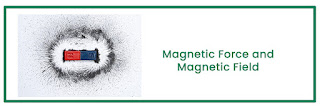Magnetic Force and Magnetic Field
The force exerted by a magnet on certain materials, including other magnets, is known as a magnetic force. The force is applied across a large area and includes both attractive and repulsive forces. Two magnets with opposite north and south poles attract one another, while two magnets with comparable north and south poles repel one another. Magnets can exert force across large distances due to magnetic fields.
The magnetic field surrounding a bar magnet can be seen in the image above.
Under a sheet of glass, iron filings (small iron particles) were placed. The iron filings on the glass were attracted by the magnet. The magnetic field's lines of force are depicted by the pattern of iron filings. The concentration of iron filings at the poles indicates that these are the most strong areas. It's also possible to investigate how the magnetic field affects compasses above the magnet.
When two magnets come close together, their magnetic fields interact. You can see how they interact in the diagram. The north and south poles' lines of force attract each other, but the two north poles' lines of force repel each other.
Magnets are attracted to iron, but they can also be attracted to other magnets.
When two magnets with comparable or identical poles are brought near together, they repel one another. The south pole of one magnet, for example, repels the south pole of another. The north pole of one magnet repels the north pole of another in the same way.
When two magnets' opposite poles get near together, they attract each other. The south pole of one magnet, for example, attracts the north pole of another.
Click to read more science notes for class 6
How Do Magnets Work?
Properties of a Magnet
Tag - Class6 science notes; NCERT science for class 6; magnetic force example; magnetic force class 6; magnetic fields lines; online classes for school

Comments
Post a Comment
Thank you we will contact ASAP.